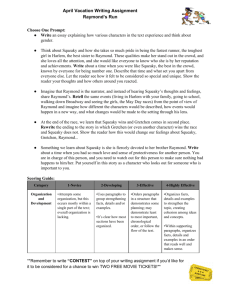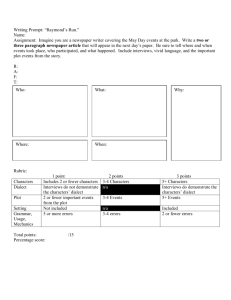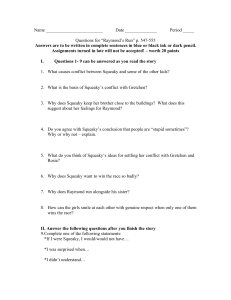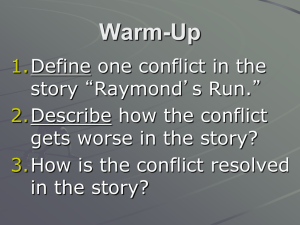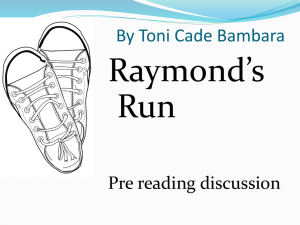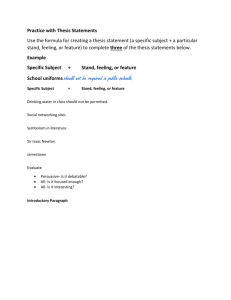“Raymond's Run” Lessons and Notes - MSEnglish8
advertisement
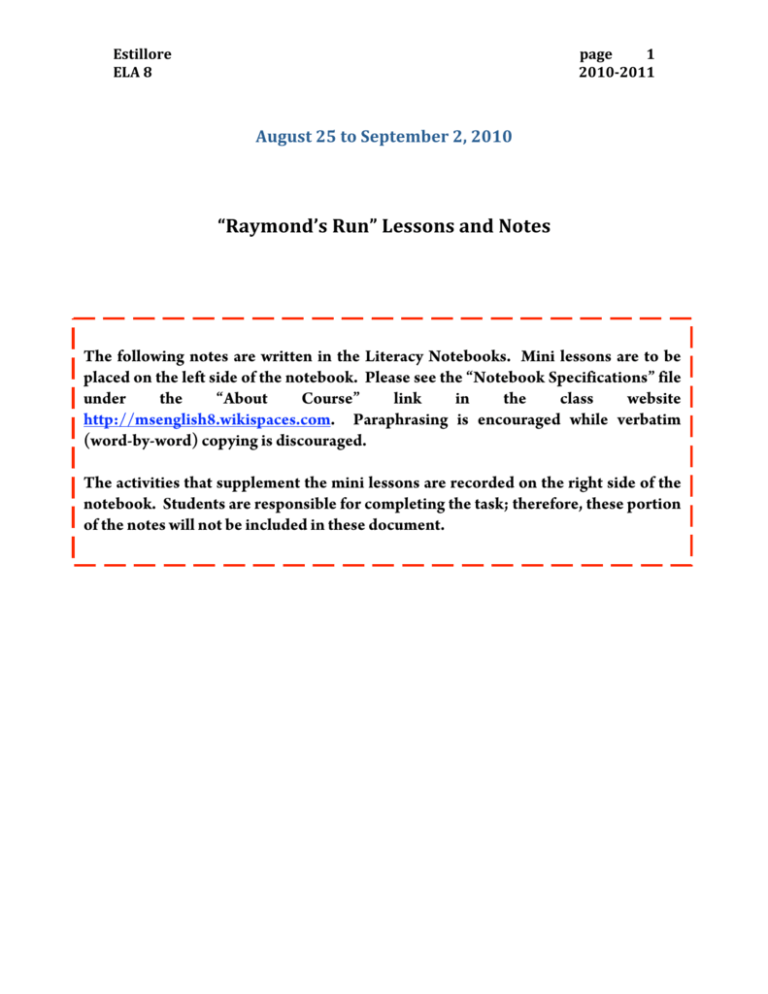
Estillore page 1 ELA 8 2010­2011 August 25 to September 2, 2010 “Raymond’s Run” Lessons and Notes The following notes are written in the Literacy Notebooks. Mini lessons are to be placed on the left side of the notebook. Please see the “Notebook Specifications” file under the “About Course” link in the class website http://msenglish8.wikispaces.com. Paraphrasing is encouraged while verbatim (word-by-word) copying is discouraged. The activities that supplement the mini lessons are recorded on the right side of the notebook. Students are responsible for completing the task; therefore, these portion of the notes will not be included in these document. Estillore page 2 ELA 8 2010­2011 Mini Lesson: Genre Study Terminology/Concept Definitions/Comments/Notes different types of anything (movies, books, literature, songs, etc.) * Genre * Literary types ‐‐‐‐‐‐‐‐‐‐‐‐‐‐‐‐‐‐‐‐‐‐‐‐‐‐‐‐‐‐‐‐‐‐‐‐‐‐‐‐‐‐‐‐‐‐‐‐ ­­ science fiction, autobiography, biography, fiction (novels, short stories, fantasy), nonfiction (documentary, expository/informative), poetry, prose (essays, research papers), magazines, newspaper, blogs, articles, letters, memoirs, personal narratives, diary, plays, guides (travel, map, etc.), encyclopedia, dictionary, reference materials, test/exams ­­­­­­­­­­­­­­­­­­­­­­­­­­­­­­­­­­­­­­­­­ Estillore page 3 ELA 8 2010­2011 Mini Lesson: Vocabulary Study Text: “Raymond’s Run” (Interactive Reader, p. 6) Terminology/Concept * affect (v.) * conclude (v.) * evident (adj.) * imply (v.) * initial (adj.) * relay (n.) * clutch (v.) * prodigy (n.) * liable (adj.) * sidekick (n.) * crouch (v.) Definitions/Comments/Notes To bring about some change Reach a decision Obvious Express indirectly (read between the lines) First Race (as in competing/running) Grasp Talented/has exceptional quality Responsible to/for something/someone Close friend Bend down/creeping­squatting movement Estillore page 4 ELA 8 2010­2011 Mini Lesson: Literary Analysis ­ Plot Text: “Raymond’s Run” (Interactive Reader, p. 6) Terminology/Concept **SEE separate graphic organizer*** (Graphic Organizer Folder StoryPlotTerms file) See “storyplotterms.pdf” in the “Graphic Organizer” under the “About Course” link of the website. Draw the information in your notebook. Do Not Simply Print and Paste onto the Notebook. Definitions/Comments/Notes Estillore page 5 ELA 8 2010­2011 Mini Lesson: Close Reading Strategies ­ Inference Terminology/Concept * Inference Definitions/Comments/Notes Educated guess/hypothesis an assumption Imply, *conclude, suggest, probably, maybe, might, possibly, could, perhaps, convey, assume Estillore page 6 ELA 8 2010­2011 Mini Lesson: Close Reading Strategies – Conflict Terminology/Concept * Conflict * Types of Conflict * Examples of thematic conflicts Definitions/Comments/Notes Problem in a story; struggle that takes place in a text Internal – problem within the character External – problem with another character Man v. Man Man v. World/Society Man v. Nature Man v. Self Estillore page ELA 8 2010­2011 7 Mini Lesson: Close Reading Strategies – Characterization Terminology/Concept * Characterization * Examples of characteristics or traits * Types of characters Definitions/Comments/Notes ­ the way a writer creates and develops characters ­ 4 ways that writers create characters: * through physical descriptions and attributes * through dialog and/or conversations about and within characters * through indulging the thoughts, motivations, feelings, speech of the character * through comments made about characters on other characters by the narrator loud, serious, funny, sensitive, exciting, vicious, angry dynamic – who goes through or shows change flat – who remains the same or changes very little Estillore page ELA 8 2010­2011 8 August 25 to September 2, 2010 “Raymond’s Run” Activities and Notes The following notes are written in the Literacy Notebooks. Mini lessons are to be placed on the left side of the notebook. Please see the “Notebook Specifications” file under the “About Course” link in the class website http://msenglish8.wikispaces.com. Paraphrasing is encouraged while verbatim (word-by-word) copying is discouraged. The activities that supplement the mini lessons are recorded on the right side of the notebook. Students are responsible for completing the task; therefore, these portion of the notes will not be included in these document. Estillore page ELA 8 2010­2011 9 Activity: Dialectical Journal Entry Focusing On Conflict Comments/Notes Quote (page number) 1) * “…if anybody has anything to say to Raymond, anything to say about his big head, they have to come by me” (IR, 6). 2) “…now she [Mary Louise] hangs out with the new girl Gretchen talks about me like a dog…” (IR, 9) 3) Students supply additional quote analysis from the Interactive Reader 4) Students supply additional quote analysis from the Interactive Reader 5) Students supply additional quote analysis from the Interactive Reader * Squeaky has to deal with people making fun/ridiculing/talking about her brother Raymond because he has a brain disorder. This internal conflict causes her to act tough, which is why people see her as a cocky person. (Man v. Self, v. Man, v. World/Society) * Squeaky is not friends with ML anymore because she and Gretchen started to talk about her behind her back. This is an example of an external conflict because Squeaky has to deal with the other girls as well as to protect Raymond from ridicule. (Man v. Man, v. world/society, v. Self) Estillore page ELA 8 2010­2011 10 Dialectical Journal Entry Focusing On Characterization Text: “Raymond’s Run” (Interactive Reader, p. 6) Quote (page number) * Quote on Squeaky: “’I always win cause I’m the best’” (IR, 10) * Quote on Squeaky: “ * Quote on Raymond: “ * Quote on Gretchen: “ Trait/Comments/Notes * (trait) confident/determined; this quote shows that she is confident/determined because she takes up for Raymond no matter what anybody else thinks or says. Estillore page ELA 8 2010­2011 Activity on “Raymond’s Run” – Plot Outline (Draw the diagram on p. 17 of IR) Exposition • Setting – where – Harlem, NY; when – 20th c. or modern time • Characters – Squeaky, Raymond, Mary Louise, Cynthia Proctor, Gretchen, Rosie, parents, George (brother), Mr. Pearson • Conflict – (definition – problem/struggle) – Squeaky has to win the race and take care of her brother, Raymond. Rising Action • Squeaky is about to run the race. • While preparing to race, Squeaky has to keep in mind how people treat Raymond. • Squeaky is determined to outrun Gretchen. Climax • Squeaky realizes that she can help Raymond achieve something. Winning isn’t everything. She aspires to pursue other interests. Falling Action • Squeaky wins the race, 1st place. • Gretchen wins 2nd place. Resolution • Squeaky saw that Gretchen is also a capable runner and began to respect her. • Squeaky still has to protect Raymond, but she will deal with less confrontation. 11
